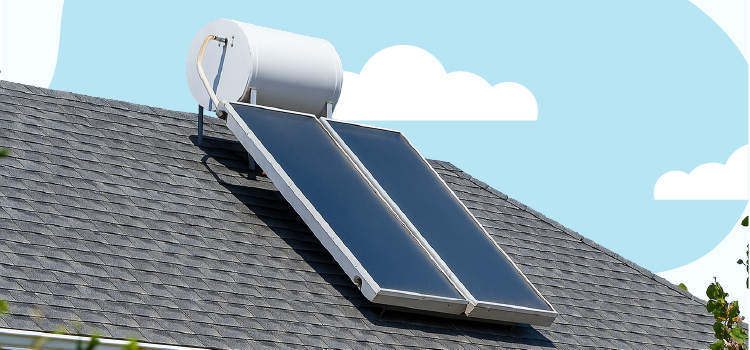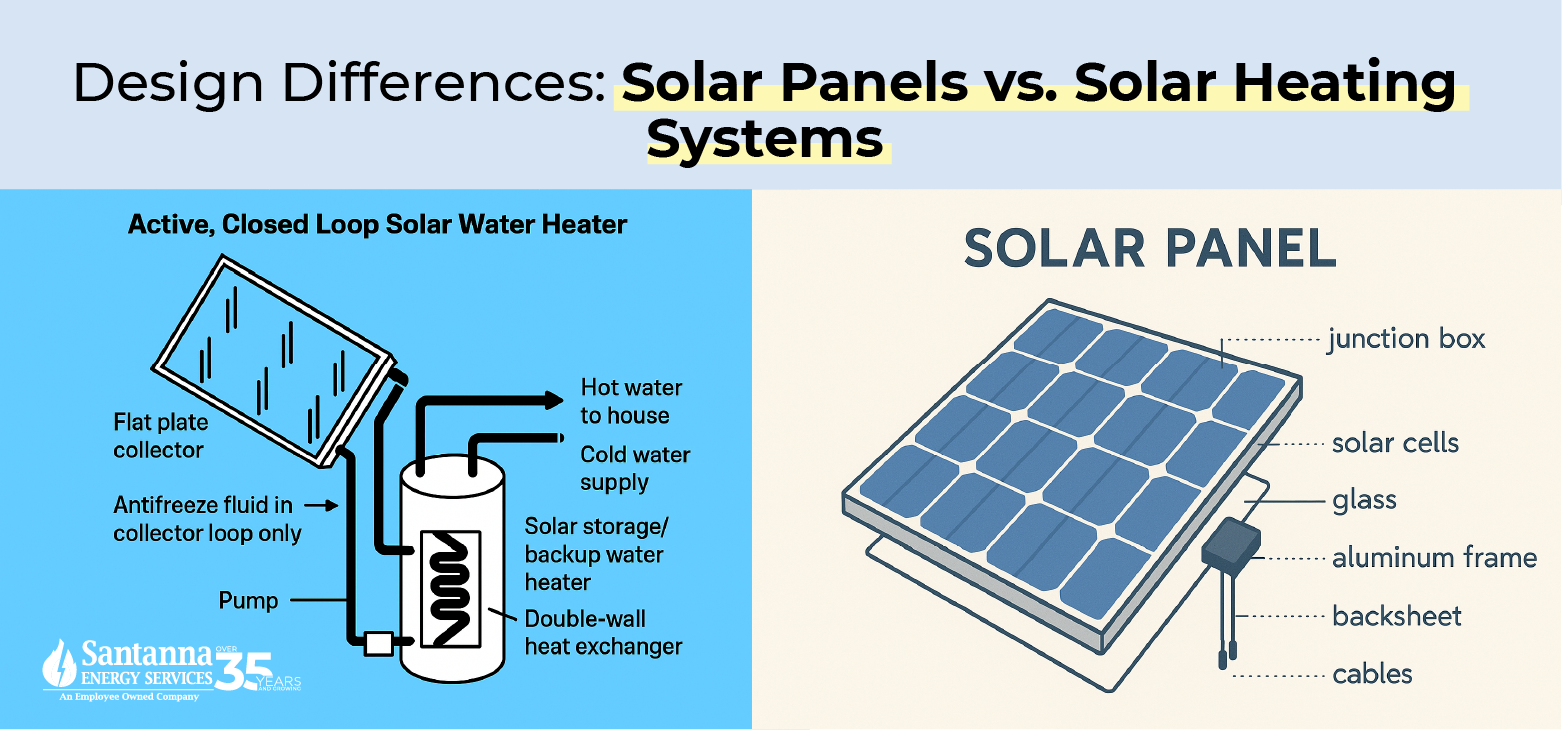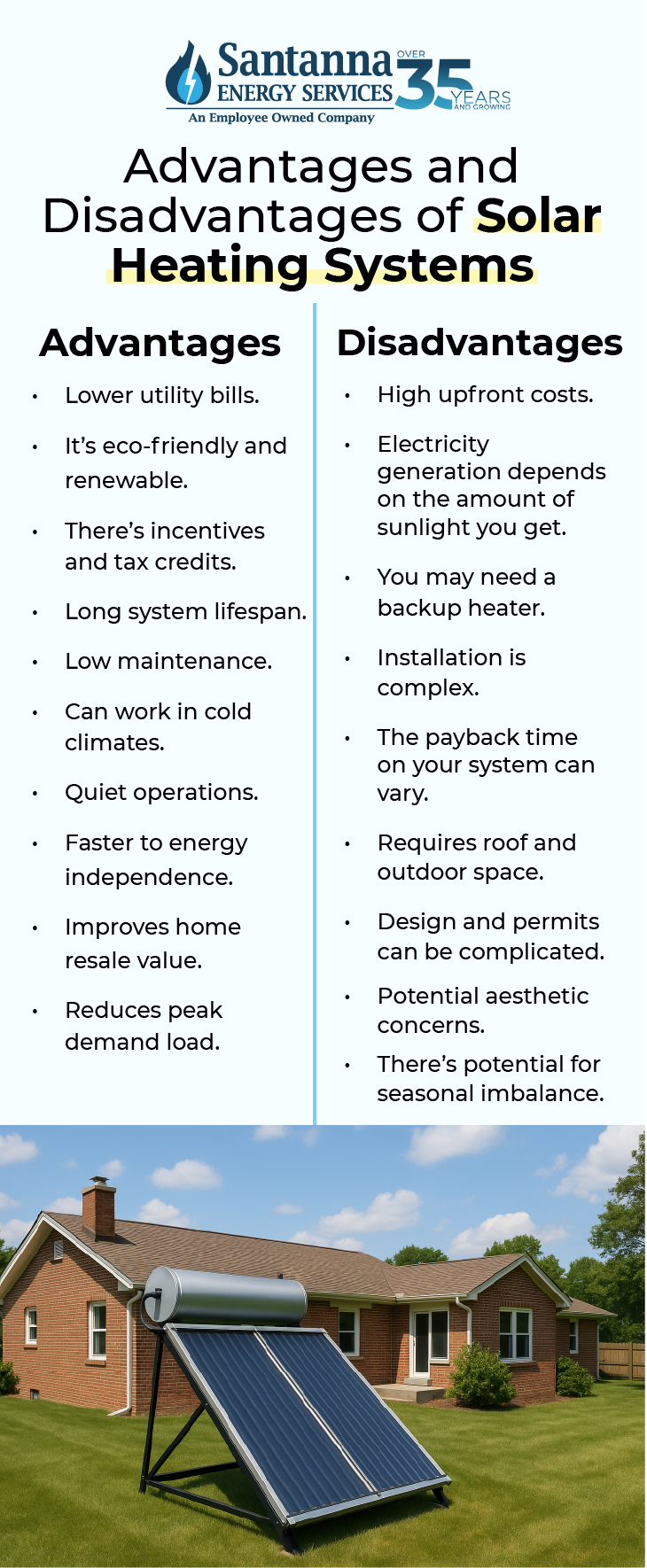What are the Advantages and Disadvantages of Solar Heating Systems?
by Tyler Castle
24.9 min read

Let’s face it, home heating isn’t getting any cheaper, and energy bills always seem to rise faster than your thermostat setting on a January morning. So, when you hear about solar heating systems, it sounds like a no-brainer: free energy from the sun? Yes, please.
But solar heating isn’t just about warming up your house. While these systems can help you slash your utility bills, they’re not a one-size-fits-all solution. Your climate, your roof, and even your hot water habits can tip the scale from “great investment” to “why did I do this?”
In this guide, we’re breaking down the real disadvantages and advantages of solar heating systems, cutting through the jargon to help you figure out if solar heating is the right move for you. Let’s dive in.
Key Points of This Article:
- Homeowners can reduce water heating costs by 50–80% using solar thermal systems, especially in sunny regions. These systems are eco-friendly, quiet, and can increase home resale value.
- Solar heating systems require proper roof orientation, minimal shading, and sometimes structural modifications. They may also need backup heating sources during cloudy or winter days.
- Key advantages include: Lower energy bills, eco-friendliness, long lifespan (25–30 years), quiet operation, low maintenance, and eligibility for tax credits and rebates. Solar heating also promotes energy independence and can boost property value.
- Key disadvantages include: High upfront costs, dependence on sunlight, need for backup systems, complex installation, long payback periods, and potential aesthetic or structural concerns. Not all homes or climates are suitable, and some may face HOA or permit restrictions
What Is a Solar Heating System?
When most people think of solar energy, they picture rooftop panels generating electricity. But not all solar systems are specifically designed to power your lights or charge your phone. Some are designed specifically to generate heat and that’s where solar heating systems come in.
Here’s the key difference between solar panel systems and solar heating systems:
- Solar PV (Photovoltaic) Systems convert sunlight into electricity. These are the panels that power lights, appliances, and devices and are typically installed on your roof.
- Solar Thermal Systems which is then used to warm water, heat your home, or both. These systems can also be installed on your roof, or placed on the ground.
Two Common Uses for Solar Heating Systems
Solar thermal systems are typically used in two main ways:
- To Heat Water – These systems provide domestic hot water for showers, dishwashing, laundry, or pools. They can supplement or replace a traditional water heater.
- To Heat Your Home – These systems can warm living spaces through radiant floor heating, baseboard heaters, or forced-air systems. This application is more complex and climate-dependent but can help lower winter heating costs in the right conditions.
Instead of converting sunlight into electrical energy, solar thermal systems use solar collectors (like flat panels or tubes) to absorb the sun’s heat. This heat is then transferred to water or another heat-transfer fluid, which flows through pipes into a storage tank or heating system.

How Do Solar Heating Systems Work?
The best way to understand the advantages and disadvantages of solar heating systems is to understand how the system works.
Imagine using the sun like a giant heater for your home. That’s basically what a solar heating system does, it collects heat from the sun and uses it to warm up your water for your house.
Here’s how solar heating systems work, step by step:
1. Solar Collectors
It all starts with the solar panel collectors. Solar collectors are often flat panels installed on your roof or yard that absorb sunlight. Once installed, these collectors absorb sunlight and use it to heat a liquid (either water or a special antifreeze solution) inside the system.
2. Heat Transfer
The heated water moves through your system in two ways:
- In active solar heating systems, a pump moves the heated fluid to a tank, where it transfers heat to the water inside of your home.
- In passive solar heating systems, gravity and natural convection move the fluid without the use of pumps.
3. Storage and Use
The heat is stored in a tank and used when needed, for hot showers, dishwashing, laundry, or home heating.
The Most Common Types of Solar Heating Systems
Before installing a solar heating system, allow us to break down the most common heating systems and which is right for your home.
Solar heating systems come in two main types: active systems and passive systems. The right one for you depends on your climate, budget, and how much heating you need.
Active Solar Heating Systems (Pumps + Controls)
Active systems are the most common in colder regions like Pennsylvania, Illinois, Michigan, and Ohio. Why? Because they’re more powerful and flexible, and they work even when sunlight is limited.
Active solar heating systems use pumps or fans to move heat from the solar collectors to where it’s needed (like your water tank or heating system). Electronic controls help regulate temperatures and flow, ensuring the system runs efficiently.
These systems can be used for both space heating and water heating, often with better performance in larger or colder homes.
If you live somewhere with long winters or less sunlight, we’ve found an active system gives you more control, and more consistent results. That active solar heating is typically more effective in colder climates and can be paired with conventional systems for year-round use.
Passive Solar Heating Systems (Gravity + Natural Flow)
Passive systems don’t use pumps or electric controls; they rely on gravity and natural circulation to move heat. That makes them simpler and often cheaper, but also more limited in what they can do.
Passive solar heating systems work like this: as water or fluid heats up in the solar collector, it naturally rises and flows into a storage tank without any mechanical help. This works best when the tank is positioned above the collector, allowing gravity to do the work.
Passive systems are usually used for solar water heating, not full-home heating.
Passive systems are great for mild, sunny climates where you don’t need intense heating and where simplicity and low maintenance are key. You should choose a passive solar heating system if you want a low-maintenance setup, live in a warm region, or have a smaller household with modest hot water needs.
Solar Heating vs. Other Heating Systems: What’s the Difference?
If you’re considering a solar heating system and wondering how it compares to traditional heating systems, we’ve got all you need to know.
Not all heating systems work the same and not all “solar” systems do what you think. Here’s a quick breakdown of how solar heating compares to solar panels, traditional gas or electric heaters, and high-efficiency alternatives so you can see which option fits your home best.
Solar Heating vs. Other Heating Systems
| Feature | Solar Heating | Solar Panels (PV) | Conventional Heaters | Energy-Efficient Heaters |
| Main Use | Heats water/air | Generates electricity | Heats water (gas/electric) | Heats water efficiently |
| How It Works | Captures sun’s heat | Converts sunlight to electricity | Burns fuel or uses electricity | Uses tech like heat pumps or tankless |
| Sunlight Required? | Yes | Yes | No | No |
| Upfront Cost | Moderate to High | High | Low to Moderate | Moderate |
| Monthly Savings | High (on heating costs) | High (on electric bill) | Low | Moderate |
| Needs Backup? | Yes (on cloudy days) | Optional battery | No | No |
| Placement | Roof or ground-mounted panels | Must be roof-mounted with ideal tilt/slope | Installed indoors | Installed indoors |
| Best For | Cutting gas bills & eco-living | Powering your whole home | Basic, affordable setup | Small households or mild climates |
In the end, choosing the right heating system depends on your budget, location, and household needs.
We recommend solar heating systems for homeowners looking to cut down on gas bills and live more sustainably, especially if they get good sunlight and want to heat water or indoor spaces. However, they do require a backup system for cloudy days.
Solar panels (PV systems) are better suited for those looking to power their entire home with renewable electricity, though they come with higher upfront costs and need a well-positioned roof.
If you’re seeking a more affordable and straightforward heating solution, conventional gas or electric heaters are reliable and work in any weather, but they can offer limited savings and long-term sustainability.
Energy-efficient systems like heat pumps or tankless water heaters work well for small households or homes in mild climates, offering a balance between moderate upfront costs and decent monthly savings.
What are the Advantages and Disadvantages of Solar Heating Systems?
Still unsure of what’s in it for you when it comes to solar heating? This heating system isn’t perfect for every home.
We know that, so we’ve done the work for you by pulling the key benefits and limitations so you can decide if solar heating is the right fit for your location, lifestyle, and budget. Here’s what you should know about the disadvantages and advantages of solar heating systems:
Advantages of Solar Heating Systems
There are many really enticing advantages of solar heating systems. Here’s what makes it a smart move for many homeowners:
- Lower Utility Bills: Solar heating systems use the sun’s free energy to heat your water or home, reducing your reliance on gas, oil, or electricity. Many homeowners’ report savings of 50–80% on their water heating costs after switching to a solar heating system.
- Eco-Friendly and Renewable: Solar energy is clean and renewable. Using it reduces your carbon footprint and helps cut down on fossil fuel consumption. With this being said, solar energy will never run out making your heating supply paired with a solar heating system virtually limitless.
- Incentives and Tax Credits: Many states offer rebates, tax credits, and other incentives that can help pay to upgrade your heating system to a solar one. EnergyStar.gov in particular, cites a cost reduction of 26–30% or more just from installing a solar heating system.
- Long System Lifespan: Well-installed solar heating systems can last 25–30 years or more with minimal issues. The collectors themselves are durable and designed for harsh weather. On the other hand, a gas furnace lasts only 15-20 years on average making solar heating systems last 25% to 100% longer, depending on the specific system and maintenance.
- Low Maintenance: Solar thermal systems have few moving parts, especially when it comes to passive systems. Once installed, they require little day-to-day care aside from periodic inspections.
- Can Work in Cold Climates: With the right setup (especially active systems with antifreeze solutions), solar heating performs well even in places with long winters with consistent sunlight.
- Quiet Operation: Unlike traditional heaters or furnaces, solar thermal systems are silent. No noisy fans, motors, or pumps (unless it’s an active system and even then, it’s minimal).
- Energy Independence: Generating your own heat through solar heating systems reduces your dependence on fossil fuels to heat your home. Since fossil fuels are non-renewable energy sources, they’ll eventually run out. But when you power your home with solar, you’re making your home more earth-friendly and you have virtually limitless heating power.
- Improves Home Resale Value: Homes with solar features often sell faster and at higher prices. According to CNBC, adding solar panels can increase your home’s value by 4.1% or more. With solar panels becoming a hot commodity, this number could be on the rise.
- Reduces Peak Demand Loads: Heating your own water with a solar heating system during peak hours (like mornings and evenings) can ease strain on the power grid.
While solar thermal systems don’t draw electricity from the grid, their use can reduce overall demand on the grid itself, especially in homes that would otherwise rely on electric water heaters. This, in turn, helps lower the risk of grid overload, rate surges, or even blackouts during high-demand times.
Disadvantages of Solar Heating Systems
Just like any heating system, there are some disadvantages to solar heating systems you should know before making your ultimate decision. Solar heating isn’t fit for everyone. Here are 10 real-world drawbacks to keep in mind:
- High Upfront Cost: Installing a solar heating system requires a significant investment upfront, especially when factoring in both the equipment and professional installation. Without available incentives or rebates, it can feel like a major financial commitment for many homeowners.
- Your Electricity Generation Depends on Sunlight: If your home gets a lot of shade or faces the wrong direction, performance drops significantly. Too much shade or not enough pitch in your roof can affect how much energy your solar panels produce. Trees, nearby buildings, or even roof obstructions like chimneys can cast shadows that reduce output as well. Before committing to a solar heating system, we recommend you schedule an appointment with a solar panel consultant to ensure your roof and home have the right conditions to provide enough sunlight and power to heat your home.
- You May Need a Backup Heater: On cloudy days or in winter, solar heating may not meet all your needs. If your energy supply is running low, it’s a good idea to be prepared with an alternative water heating source. If sunlight is limited and your system can’t keep up, you’ll want a backup water heater to avoid cold showers. The same goes for solar heating systems that heat your home. Solar thermal systems may struggle to maintain indoor comfort during long stretches of low sunlight, always be prepared with an alternative heating source like a space heater so you’re not left freezing overnight if your energy runs out.
- Installation Complexity: Installing a solar heating system isn’t a one-size-fits-all process. Several factors can impact the difficulty and cost of installation. Your roof’s strength must be able to support the weight of the collectors, especially if snow load is a concern in your region. Additionally, your existing plumbing layout can affect how easily the system can be integrated into your home. Homes with long pipe runs or older plumbing may require more retrofitting. In some cases, homeowners may opt for ground-mounted systems if the roof isn’t suitable, though that requires available yard space and may involve additional labor or permitting.
- The Payback Time on Your System Can Vary: While solar heating systems can save money over time, it can take up to 11 years to fully recoup your initial investment, depending on usage and climate. If your climate or home doesn’t have the ideal conditions to support your energy needs, this payback period can take way longer. This is especially important for those who don’t plan on staying in their home long term as you may not live there long enough to see the full return on your investment, making upfront costs harder to justify.
- Not Ideal for Every Climate: In areas with long periods of overcast skies, solar heating may underperform without expensive upgrades or oversized systems. Limited sunlight reduces the system’s efficiency, meaning you may need a larger collector area, more advanced heat storage, or backup heating sources to maintain comfort.
- Requires Roof or Outdoor Space: You need an unshaded, sun-facing area either on your roof or in your yard to install solar collectors. While the panels can be mounted at ground level, they still need significant sun for most of the day to work effectively. This setup may not be suitable for shaded lots, or multi-family units.
- Design and Permits Can Be Complicated: Depending on your state and municipality, you may need multiple permits, inspections, or engineering reviews before installation. In some cases, after a detailed review, your home might be deemed unsuitable for installation. That’s why it’s essential to ask plenty of questions and fully understand the permitting and design process upfront, so you don’t invest time or money into a system that ultimately won’t work for your home.
- Potential Aesthetic Concerns: Some homeowners or HOAs may feel solar collectors aren’t visually appealing, especially on older or historic homes. If this is the case for your home, you might receive some pushback. Collectors can be bulky and may disrupt the visual harmony of a carefully designed roofline or façade. In neighborhoods with strict design guidelines or preservation rules, this could lead to restrictions. If maintaining curb appeal or historical accuracy is a priority, or if you live in a community with aesthetic regulations, it’s important to check local guidelines and explore alternative mounting options.
- Seasonal Imbalance: You might generate more heat than you need in summer and not quite enough in winter, unless your system is carefully sized and supplemented. This mismatch between energy production and demand can lead to inefficiencies, such as wasted heat during warmer months or insufficient heating during peak winter usage.

Pros and Cons of Solar-Powered Hot Water
Solar water heating is one of the most common uses of solar thermal energy. Instead of heating your whole house, this system focuses on your daily hot water needs for showers, laundry, dishes, and more. It’s often simpler and more affordable than full-home solar heating, but still comes with its own unique pros and cons.
Here’s what you should really know if you’re considering solar-powered hot water:
Pros of Solar Water Heaters (That Go Beyond the Basics)
- Perfect for Homes with High Hot Water Use: If your household uses a lot of hot water (think: multiple people, frequent laundry, long showers), solar water heating makes a big impact.
- Great for Pools, Too: Many homeowners use solar water systems just for pool heating, which can drastically reduce seasonal energy bills.
- Simple Tech, High Efficiency: Solar water heating is one of the most energy-efficient renewable upgrades, with thermal efficiency often exceeding 70%.
- Faster Return on Investment Than Solar Panels: Since these systems are cheaper than solar PV, and hot water use is consistent year-round, payback periods can be shorter.
- Can Be Integrated with Existing Systems: Solar water systems can work alongside your existing gas or electric heater, reducing demand without requiring a full replacement.
- No Batteries or Grid Ties Required: Unlike solar electricity systems, you don’t need to install batteries or get permission to connect to the power grid.
- Consistent Performance in Summer Months: Water heaters run most efficiently in warm, sunny months. When solar thermal collection is at its peak in the summer months, you’ll most likely have limitless hot water.
- Flexible Configurations: Solar water heating systems can be mounted on the roof, ground, or even wall-mounted collectors, depending on your home layout.
- Low-Temperature Applications Are Ideal: Most households only need hot water at 120–140°F, which means solar water heating systems operate at lower temperatures than space heating systems, according to the U.S. Department of Energy. This makes them less sensitive to outdoor temperature drops and helps reduce energy waste.
- Good Entry Point for Going Solar: For homeowners who aren’t ready to invest in a full solar panel system, solar hot water offers an affordable, low-risk introduction to renewable energy.
Cons of Solar Powered Hot Water (That You Might Not Expect)
- Risk of Overheating in Summer: In hot climates or summer months, solar water systems can produce more hot water than needed, which can stress the system without proper heat-dumping features.
- You Might Need More Roof Space Than You Think: Even just heating water can take up a surprising amount of collector space, especially for larger families. To power a water heater, you’ll need roughly three solar panels to do so. Solar panels are typically 65 inches long and 39 inches wide which means to place three solar panels on your roof to power your solar water system, you’ll need roughly 35 feet of roof space. This might not sound like a lot, but for homeowners with limited roof space and shady roof areas, this space can be hard to come by.
- Insulation Matters a Lot: Without proper pipe insulation and tank coverage, heat loss can be a problem, especially in colder climates. Heat loss means less power you’ll be able to generate from your system.
- Installation May Affect Roof Structure: Tanks mounted on the roof (for passive systems) are heavy and may require reinforcement. This is an extra that a homeowner might not factor in when considering a solar water heating system.
- Plumbing Compatibility Issues: Older homes may need upgraded piping or water heaters to accommodate the new system, increasing labor costs.
- Freeze Protection is a Must in Cold Climates: If not properly designed, systems can freeze or burst in winter. Glycol systems or drain-back designs are needed in places with cold climates.
- Storage Tank Size Must Match Your Use: Undersized tanks will run out of hot water; oversized tanks may waste energy. Sizing mistakes lead to poor performance.
- You May Experience Inconsistent Water Temperatures Without a Mixing Valve: Without a temperature regulator, water may get too hot and pose a scalding risk.
- Not Ideal for Low Water Users: If you only use minimal hot water each day, you might not get enough savings to justify the cost.
- May Void Roofing Warranty: Some roofing manufacturers won’t honor warranties if solar collectors are added, so always check before installing.
How Much Do Solar Heating Systems Cost?
The cost of a solar heating system can vary quite a bit depending on your location, household size, hot water needs, and the type of system you choose (active vs. passive). But to give you a general idea:
Most homeowners spend around $3,706 to install a solar water heating system, with prices typically ranging between $1,780 and $5,722 depending on complexity and size.
This price usually includes the solar collectors, storage tank, plumbing, and labor. Larger homes or those in colder climates may need higher-capacity systems or additional components like antifreeze or heat exchangers, which can increase the total cost.
How Much Can I Save on Energy Bills Per Year With a Solar Water Heater?
If you install a solar water heater, you could cut your water heating bills by 50% to 80% according to the Department of Energy because you’re using the sun instead of paying for gas or electricity. And since sunshine is free to generate from, you won’t have to worry about fuel price hikes in the future.
It gets even better if you’re building a new home or refinancing. You can roll the cost of the system into your mortgage, which might only add about $13 to $20 a month. With tax deductions, that drops a few dollars more. So if you’re saving more than $15 on your energy bill each month, the system basically pays for itself right away.
This might not seem like a huge deal, but it can pay off in the long run.
Is Solar Heating Worth it in Pennsylvania, Illinois, Ohio, and Michigan?
If you live in the Midwest or Northeast, solar heating can be a worthwhile investment. Before you make the switch, here are some important things to consider based on your state’s climate, sun exposure, and incentives:
Solar Heating Systems in Pennsylvania
PA gets a mix of sun and clouds, including cloudy winters. Solar systems, especially active types with freeze protection, are well suited for this climate.
When it comes to incentives and rebates, the PA Sunshine Solar Rebate Program offers rebates up to 35% or $5,000 for residential investing in solar thermal projects. With high energy efficiency standards and generous rebates, PA homeowners can install solar heating affordably, reduce bills, and lower heating emissions.
Solar Heating Systems in Illinois
Despite cold winters, Illinois receives enough sunlight to enable efficient solar thermal heating, especially when paired with modern evacuated-tube collectors. Solar heating systems can perform well year-round with proper system design.
When it comes to incentives in Illinois, Programs like Illinois Shines and CEJA provide tax incentives and financial credits that make solar heating cost-effective. Illinois homeowners can offset up to 70% of their HVAC energy costs using solar heating and cooling solutions.
Solar Heating Systems in Ohio
Ohio gets a decent amount of sunlight throughout the year, which makes it a good place for solar water heating, especially when the system is set up correctly. Even with some cloudy days, solar can still do a lot of the work to heat your water and lower your energy bills.
Though fewer direct solar thermal rebates exist, homeowners can still claim the 30% federal tax credit, local utility rebates, and benefit from Ohio’s renewable portfolio standard and net-metering programs.
Solar hot water can effectively reduce natural gas and electric bills. Proper system sizing enhances performance in changing weather.
Solar Heating Systems in Michigan
Michigan receives less sunlight than other states listed, but with active systems and anti-freeze designs, solar thermal remains viable, especially in summer and shoulder months. Performance will likely be seasonal, and backup heating is essential.
Though statewide incentives are limited, utility providers like Consumers Energy and DTE offer rebates and energy-efficiency programs.
Even with limited sun, solar heating helps reduce dependency on electric or propane systems, especially when combined with incentives and proper winterization.
According to U.S. Department of Energy if you live in Pennsylvania, Illinois, or Ohio, your home is likely a great candidate for a solar water heating system, especially if you have a roof or yard with good sun exposure and access to local incentives.
If you’re in Michigan, solar heating can still work, but performance may vary more by season. In that case, be sure to choose a qualified installer familiar with cold-climate solar systems.
Are Solar Water Heaters Worth It?
A solar water heater can absolutely be worth it if your home, lifestyle, and location are a good match. It’s one of the most practical ways to use solar energy, especially if you’re looking to lower your monthly bills and reduce your reliance on fossil fuels. And with the right system design, many homeowners see strong long-term savings, often 50–80% off their water heating costs.
But like any home upgrade, it’s not a one-size-fits-all solution. Whether or not it’s “worth it” depends on several key factors: how much sun your roof gets, how much hot water your household uses, your budget, and how long you plan to stay in the home.
To help you make a confident decision, here’s a quick guide to when a solar water heating system makes sense—and when it might not.
Install a Solar Heating System If…
- You use a lot of hot water daily (large family, frequent laundry, multiple bathrooms).
- Your home has a sunny, south-facing roof with minimal shading.
- You live in a state with strong solar incentives or rebates.
- You’re planning to stay in your home long-term.
- You’re comfortable with a backup system for cloudy days.
- You want to reduce your carbon footprint and use more renewable energy.
- You’re building a new home or refinancing and can roll the system into your mortgage.
- You already pay high energy prices for water heating (especially propane or electric).
- You’re looking for a low-maintenance, quiet, and efficient upgrade.
Do Not Install a Solar Heating System If…
- Your roof is shaded, doesn’t face the right direction, or is too small for collectors.
- You live in a very cloudy region and don’t want to rely on a backup heater.
- Your hot water usage is minimal.
- You’re renting or planning to move within a few years.
- You don’t qualify for incentives and the full cost doesn’t fit your budget.
- You’re not ready for the upfront investment.
- You have concerns about roof aesthetics, structural changes, or HOA restrictions.
- Your home’s plumbing system is outdated and would require major upgrades.
- You want a simple plug-and-play upgrade.
- Your priority is powering your home, not heating water.
Frequently Asked Questions
Can a solar water heater fully replace my current system?
Sometimes—but not always. Most homes still need a backup water heater for cloudy days, high usage, or winter months. A solar system typically supplements your current system rather than fully replaces it.
Why do most people choose active solar water heaters?
Active systems use pumps and controllers to circulate fluid, making them more efficient, reliable, and better suited for colder climates. Passive systems are simpler but perform best in warm, sunny areas.
Does solar work well in cloudy or cold weather?
Yes—if the system is properly designed. Solar water heaters still collect heat even on cloudy days and in cold weather, especially active systems with freeze protection. Efficiency may be lower, but they still work.
Can I install a solar heater myself?
We don’t recommend it unless you have advanced plumbing and roofing experience. Proper installation is key for performance, safety, and warranty coverage—licensed professionals should handle it.
What types of homes are suitable for solar?
Homes with unshaded, south-facing roofs and high hot water demand are ideal. You’ll also need space for a storage tank and plumbing access. Ground-mounted collectors are an option if your roof isn’t a fit.
Solar heating systems offer a powerful way to lower your utility bills, reduce your carbon footprint, and tap into the free energy of the sun. They’re durable, efficient, and can pay off in the long run.
That said, they’re not for everyone. The upfront costs, space requirements, and dependence on direct sunlight mean some homeowners may be better off with other energy-saving upgrades or waiting for the right time to invest.
But that doesn’t mean you can’t make a difference today. You don’t need rooftop panels to support clean energy. At Santanna, we make it easy to choose renewable energy for your home, with zero installation required. Explore Santanna’s Earth-Friendly Electricity Plans here. Because going green should be as simple, and as sustainable, as flipping a switch.
Tyler is an experienced energy professional, having worked for Santanna Energy Services, for the past four years. He is passionate about renewable energy and believes that diversifying the energy grid is the key to a sustainable future. Tyler is dedicated to supplying consumers with the best possible energy solutions and works diligently to make sure that Santanna can deliver the highest quality service.







